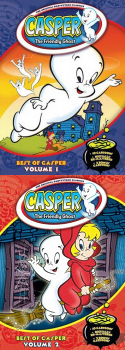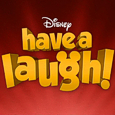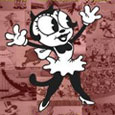Famous Studios/Harvey Comics (1951-1958), Classic Media (June 26 2007), 2 individually released discs, 72 mins each, 1.33:1 original full frame ratio, Dolby Digital Mono, Not Rated, Retail: $12.95
Volume 1 and Volume 2 each sold separately
Storyboard:
Two volumes of Casper the Friendly Ghost’s best, totalling 24 animated shorts across the two individual discs.
The Sweatbox Review:
Quite how or who came up with the selection on either of these two collections, or why they were in authority to do so matters little…the Casper cartoons were always lightweight affairs, never offensive, but certainly not in the major leagues. The Best Of Casper series, spread across two volumes, is a seemingly random selection of cartoons from the Harvey Comics animation library, which came to DVD with much criticism as The Harveytoons Complete Collection last year.
Most, if not all the titles (given a quick cursorary check) seem to be derived from that collection as well as other previously released Casper editions, including Casper And Wendy’s Ghostly Adventures and others on the Sony Wonder label. Now renamed Classic Media, the unit has been updating and reissuing many of those initial titles with an eye on the collectors’ market, but sadly not often enough with a collector’s process in place. The same can unfortunately be said for their handling of the Godzilla franchise, which attempted to start off with a deluxe collector’s series but used interlaced, non-restored transfers and poor value bonus features. While there are many out there that would like a comprehensive collection of the Harvey Comics cartoons, and especially the original Casper theatricals, Classic Media keep dropping the ball somewhat, and these two “Best Ofs” don’t even retain all the previous cartoons issued on other titles and drop quite a few.
Of course, this is better considered a sampling of Casper rather than any kind of definitive selection. The two volumes feature ten cartoons a piece, with two extras “as personally picked by Casper himself”, whatever that means. The character himself was created in the early 1940s for a children’s storybook that never took off, but there was sufficient interest from Paramount’s Famous Studios for them to acquire the little ghost in 1942. Paramount was in the process of turning the Fleischer Brothers facility into their own in-house animation unit, and were looking for characters other than the established Popeye and Superman to call their own. Casper The Friendly Ghost, which depicted the ghost as the dead spirit of a little boy, was released in 1945, and the character appeared again to two more Paramount/Famous cartoons before landing his own dedicated series that ran between 1950 and 1959.
During that spell, many Famous Studios characters made their comic book debuts, including Casper in 1952, before being bought outrightly for further exploration by Harvey Comics, the owners of Richie Rich among others, in 1957. Although the theatrical series ran for another couple of years, Casper was soon switched to television, where new cartoons were produced sporadically over the years. In later years, Harvey would explain away the rather morbid history behind why Casper was a ghost as due to the fact that his parents were ghosts when they were married, but the entertaining 1995 CGI feature film provided a more legitimate backstory that again referred to him as, in fact, a tragically passed away child. As a result of that film, the character gained something of a major comeback resurgence, starring in a new TV series and a number of direct-to-video spin-offs.
With such a recent history, it’s sometimes difficult to remember that Casper was in fact a cartoon star and not a comics creation. This is partly due to the Harvey Comics handling of the character and also down to that original decade of the theatrical cartoons themselves. Despite their popularity, Casper was an also ran to Popeye in the 1950s, a decade when theatrical cartoons were widely in decline. It didn’t help that each cartoon also followed exactly the same format: Casper, usually floating around either the halls of some old house or the lonely streets, wants to befriend the living occupants but his ghostly appearance scares them off. Before long, someone will get into danger, Casper’s help proves that not all ghosts are malevolent spirits and, if there’s any kind of villain, the sight of a “real” ghost will scare them off for good.
Saving each cartoon was the memorable theme tune, written by Disney’s Cinderella song writing team of Jerry Livingston and Mack David, which lodges itself in your head with sprightly innocence. On this disc, you’ll hear the song only once, right at the beginning if one selects the Play All option, when the disc starts with an introduction of sorts…the Harvey Films and classic Casper logos held on screen while the theme tune plays. On the cartoons themselves the main title have been dropped, featuring only the new 1990s era Harveytoons logo, leading into the title card art only. Naturally that means no original crew titles, and even the copyright has been stamped on rather heavy handedly with video captioning announcing copyright to Harvey Films Inc.
Both volumes are so identical to each other that we’ve decided to review them as one set. The first volume’s cartoon line up is: True Boo (1952), Boo Ribbon Winner (1954), Good Scream Fun (1958), Fright From Wrong (1956), Zero The Hero (1954), Ground Hog Play (1956), Boo Hoo Baby (1951), Spooking About Africa (1956), Puss ’N Boos (1954), Hide And Shriek (1954), Red, White And Boo (1955), and Pig-A-Boo (1952). The animation on the earlier cartoons is much more rounded and fuller, while the later films display cleaner, less imaginative backgrounds and more static cartooning.
While Boo Hoo Baby is very sweet and Ground Hog Play has some clever fun with comic strip panel animation, the true highlight of the first volume has to be the Three Little Pigs spoof Pig-A-Boo, when the series was still fresh and still having fun with its Chicken Boo-style recurring line of “Arrrghhh! It’s a GHOST!” before things got too routine and mundane.
The second volume features an as varied selection: Frightday The 13th (1952), Hooky Spooky (1957), Little Boo Peep (1953), North Pal (1953), Keep Your Grin Up (1955), Penguin For Your Thoughts (1956, from the same print as was included as an extra on the 1995 movie’s DVD), Spook And Span (1957), Spook No Evil (1953), Spunky Skunky (1952), Boo Bop (1957), To Boo Or Not to Boo (1951), and Spooking With A Brogue (1955). Again the earlier films express more life to them considering their lead protagonist is dead, and the Trick or Treat Halloween cartoon To Boo Or Not to Boo is perhaps better than anything else in the two volumes.
Occasionally, the Famous artists would find themselves pushing the boundaries of death in a Casper short, such as in the pre-series There’s Good Boos Tonight for example, but after A Haunting We Will Go, the series kicked in and Harvey’s increasing pressure led to a major softening of the character and tone. These Casper cartoons on the whole will appeal more to children than adult collectors, and this is where Classic have targeted their aims, presumably after poorer than expected sales of that Complete Harveytoons box that was anything but complete and suffered several bad reviews. Their treatment of the library would fare much better in a set geared towards collectors, where interest would lie in the many other cartoons produced by the studio around the time.
Unfortunately this mishandling stretches to the cartoons themselves, by way of deleting the original title plates and literally having each cartoon begin with the title card only. As mentioned above, we only hear the Casper theme once at the top of the program, and there are no end plates…until right at the end when a few pages of newly generated credits list the directors and artists names, but with no indication of who did what on which cartoons. You know, someone has to make decisions like these!
As such, these Best Of Casper volumes are hard to push one way or the other. The cartoons aren’t great, but they’re not bad. The handling of them here is poor, but they look and sound good enough and at least there are no “enhanced” sound effects! Collectors should probably hold off in the hope that we see some kind of decent edition down the line, making do with the Harveytoons Complete set if they really need to see these pronto. Those with that set should be aware that there are no additional cartoons here (everything is culled from that box), but those without that collection might be tempted to brush up on their Casper and use this as a gauge as to whether a fuller collection would be of interest if it ever appeared.
Is This Thing Loaded?
Presented as a ten-cartoon compilation, we’re led to believe that Casper has selected another couple of shorts for bonus inclusion. Well, that might work for the kids, but essentially they should just say this is a twelve title disc and be done with it.
For the record, the two “extras” on Volume 1 are Red, White And Boo and Pig-A-Boo, while Volume 2 adds To Boo Or Not To Boo and Spooking With A Brogue.
The menus (which seem to be interchangeable, meaning that a cartoon on Volume 1 is used as a basis for a menu on Volume 2) are plain and simple, offering “Episode Access” (the option to pick each cartoon), and a Play All function that includes the introduction, Bonus Cartoon selection and video generated end credits.
Each disc starts with advertisements for Gerald McBoing Boing (naturally the remake, not the long awaited Columbia classics), The Harveytoons Complete Collection boxed set, and a yukky looking all-CGI Casper video, Casper’s Scare School, that continues the downward trend that has beset the post-1995 movie spin-offs.
Case Study:
Making up for the lacklustre programming are the brightly colored covers, which do look fairly neat. Blue is the background for Volume 1, while Volume 2 takes on Wendy’s red. Previously seen art is used to depict the characters, while the graphic layout works as both products of their time and being funky enough for today’s young audiences. The front suggests something more substantial with its “Original Harveytoon Classics” banner, while the back notes that these are “Theatrical Technicolor” cartoons and then goes on to say they are presented in the “the aspect ratio of their original television exhibition”, so someone isn’t getting the right emails within the company! Design is cut and paste between the two volumes, with only images and cartoon listings seeing any change. Each sleeve is housed in a “spooky white” keepcase, a nice touch, with no additional inserts inside. Wendy, Casper’s young witch friend, is prominently featured, but I didn’t notice her, or the Ghostly Trio uncles, in any of the cartoons on either volume.
Ink And Paint:
Presented in their original theatrical ratios, the sleeve notes that the shorts here have been “beautifully remastered”, which as any collector knows means very little. As noted, each cartoon is missing original front and end titles, replaced with a much later logo. Video captioning highlights the original release dates, but assigns the copyright to Harvey Films. If you can get past those discrepancies, be aware that these are interlaced video transfers of varying levels of quality. The earlier cartoons look a little rougher, but have better animation, while the later, plainer stuff looks much cleaner. Even cartoons from the same year can look and feel vastly different, but it must be said that all look perfectly adequate, colorful, and to be fair nothing is washed out or faded.
Scratch Tracks:
Whether or not these tracks have been reproduced from original prints or later dupes is a question generally raised with Casper on DVD. Past releases have seen fairly poor soundtracks not up to any kind of standard, so at least here the best that can be said about the collection is that the audio is of the accepted quality level for material of its nature and age. The titles have been replaced on all the cartoons, of course, and the same repetitive music has been used for each new introduction. Oddly, they didn’t even use a clean source and this same cue has sound glitches, pops and seems to phase in and out with itself as it quite obviously hops from different tracks to make up the whole. Thankfully, the rest of the cartoons don’t seem to have too many of the same problems.
Final Cut:
Sadly, the first three pre-Casper series cartoons are a no-show, and there’s no real choice in the rest of the selection of cartoons. That they have lost their opening titles also doesn’t help swing the collectors’ vote to picking up these two seriously uninspiring discs, and the short running length of each compilation doesn’t quite warrant the list price either, which should really be two or three dollars cheaper. Where these editions can’t be faulted, however, are as simple introductions Casper’s world, where it’s down to the cartoons themselves to work their charm. This they do, but there would be so much more life to them given the chance to shine in some kind of cared-for edition. As it is, regurgitating the same old cartoons for compilations like these is like flogging a dead ghost.
 | ||
 |








